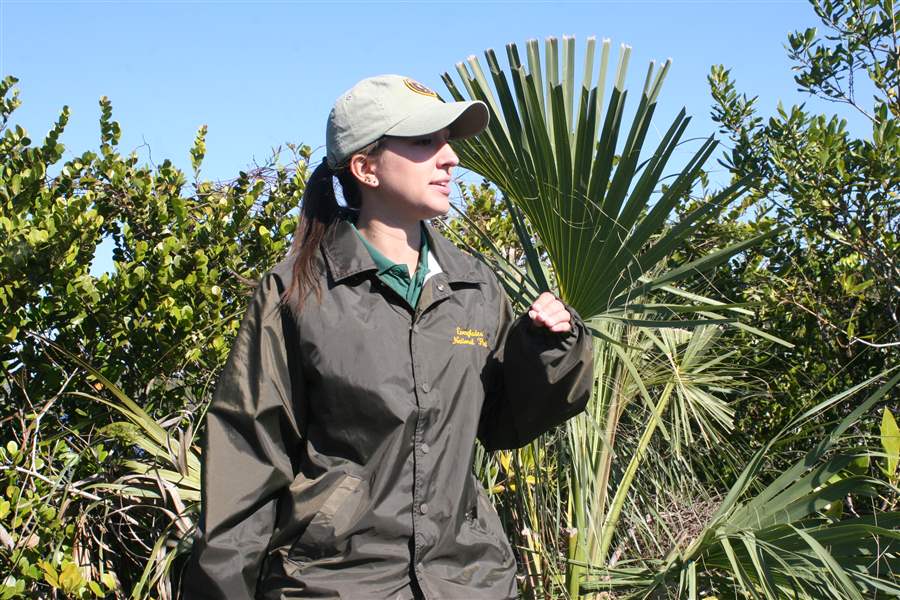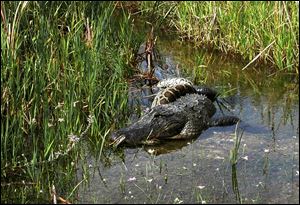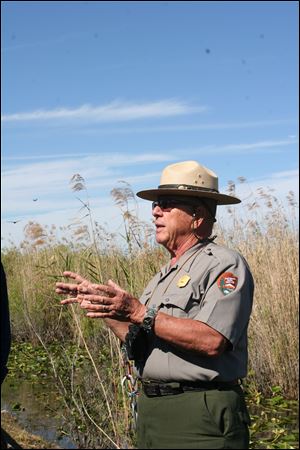
Cast a wary eye at the new folks
Dumping non-native exotic pets threatens Everglades' resident species
1/29/2012
Ranger Hayley Crowell says climate, habitat and no natural predators, suit the aliens who devour native species.
The Blade/Matt Markey
Buy This Image

An alligator bites down on the head of a non-native Burmese python as the snake attempts to defeat its foe by constriction. The scene is not unusual in the Everglades, where both species vie for food.
EVERGLADES NATIONAL PARK, Fla. -- There's no shortage of wildlife inside this vast, watery wilderness area. The problem is that a lot of the flora and fauna residing in this subtropical paradise are actually undesirable alien life forms.
Exotic species, many from half a world away, have taken up residence in the Everglades and native species are disappearing at an alarming rate. The big, bad wolf isn't knocking on the door -- he lives here.
Creatures as small as the Island Apple Snail, as bizarre as the Walking Catfish, as aggressive as the Common Myna bird, and as frightening as an 18-foot long Burmese python are here in numbers.
"In the water, on the water, on the ground and in the air - we have a lot of things that simply don't belong here," said Kirk Singer, a park ranger who spends the winter months in the Everglades and his summers working in Yellowstone.
Biologists suspect most of the invasive animals got in the Everglades through the reckless release of pets and the dumping of aquarium contents into nearby canals and ditches. Some also might have escaped pet shops during the widespread destruction wrought by Hurricane Andrew nearly two decades ago.
"That seems to be a popular thing here in the Everglades, just dump your pets or your aquarium," said Hayley Crowell, a Maryland native working as a ranger in the park.
"It's sad, but people are at the root of the problem."

Ranger Hayley Crowell says climate, habitat and no natural predators, suit the aliens who devour native species.
Once loose inside this 1.5 million acre grassy playground with its montage of wide wetlands, patches of prairie, dense and eerie hammocks and spindly waterways, these emancipated exotics tend to thrive.
With an ideal climate, prime habitat and no natural predators, they squeeze out, or devour, the native species. The invasive plants do similar damage on the vegetation side, and in the minds of some Everglades experts, could ultimately present a more serious threat to the fragile ecosystem here.
But few can argue that it's not the giant constrictor snakes that give this issue its creepy Jurassic Park feel. Pictures of a massive Burmese python that had just consumed an adult deer or of one of the huge snakes attempting to take down an alligator in the Everglades snap people to attention.
Linda Friar, the public information officer for the Everglades & Dry Tortugas National Parks, said the problem with exotic and invasive species is not unique to Florida or the Everglades, while acknowledging that a huge Burmese python has a lot more shock value than a tiny zebra mussel does as an invasive in Lake Erie.
"Every state has problems with plants and animals that don't belong there, and what to do about it," she said. "Each state has one that stands out, and I guess with the Burmese pythons, everyone else's exotics are not quite as snazzy as ours."
While each one of the invasive species has its own detrimental impact on the natural balance in the Everglades, the pythons are the poster child. Biologists believe the massive snakes have been inside the park since the 1990s or earlier, and are likely established throughout the Everglades.
Most if not all started as pets, maybe a foot long and not very threatening looking. They could be purchased for $20 at a swap meet, then taken home and raised in a small glass cage.
At first the feed is tiny mice and other rodents. But the snakes can grow to eight-feet long in a year, developing huge appetites and creating a lot of waste.
"They say 'it's cute' when they first get the snake home and it is this little thing you can handle real easily and play with," Singer said. "Then a short time later, it wants to eat your dog."
Singer attended the park's "snake school", where rangers and other staff are given a crash course in how to deal with the Burmese pythons, African pythons, and anacondas that are roaming the park.
The exotic snakes prefer to dine on birds, possums, raccoons, and muskrats that are also some of the primary food sources for one of the Everglades' most fragile populations - the Florida panther. There are believed to be fewer than 100 panthers left in the wild, and possibly less than a dozen inside the park boundaries.
The pythons grab hold of their prey with sharp, angled teeth, then wrap themselves around the prey, tightening their grip until it suffocates. They are prolific breeders, laying 50 to 100 eggs at a time.
"We really don't know how many of them are out there, but we know they are breeding, and that's not good," Singer said.
"We are trying to manage the situation as best we can, but I don't get the feeling we are winning, not at all. In a park this size, and with an animal that is so good at adapting to its surroundings, it's not much of a fair fight."

Ranger Kirk Singer explains the threats to the Everglades created by a number of exotic species -- pets that have been released into the park and taken up residence there.
Some biologists estimate that there could be 100,000 pythons scattered across the park. They are good swimmers, and one fear is that the snakes will make their way across the water to the south and infest the Florida Keys, another highly sensitive ecosystem.
Authorities have removed close to 2,000 pythons from the Everglades over the past decade, but they have no delusions about making much more than a tiny dent in the overall population.
Hundreds of thousands of these Asian snakes were legally imported into the U.S. over the past 20 years, and biologists suspect countless thousands more were produced from breeding in captivity.
A recent ruling by the U.S. Fish and Wildlife Service has banned further importation of Burmese pythons and three other nonnative constrictor snakes -- the yellow anaconda, and the northern and southern African pythons -- since these snakes are judged to be too injurious to other wildlife.
"There is a large and growing understanding of the real and immediate threat that the Burmese python and other invasive snakes pose to the Everglades and other ecosystems in the United States," said Secretary of the Interior Ken Salazar when the ban was announced.
Dealing with the pythons already in the park is a frustrating effort with few victories. Friar admits the staff suffers from a fatigue dealing with the exotics and the international interest in the complex problem.
"It wears on our science team," she said. "With the pythons, the goal right now is management. Eradication is not likely."
A pilot program that tracked the pythons with dogs was deemed to not be an effective strategy for addressing the issue, since each dog required a handler.
Another on-going effort releases captured pythons with tracking devices attached to them, hoping they lead biologists to clusters of the snakes during mating seasons.
The pythons that are captured in the park are euthanized and necropsies are performed to compile information on the health of the animal and its stomach contents. Pythons have been found to be feeding on several endangered species and every mammal in the Everglades, except the extremely rare panthers.
Larry Perez, a lifelong Miami resident and the park's science communications outreach officer, said the pythons move around a lot and make getting an accurate count on their numbers impossible.
"This is not an exact science, by any stretch," he said.
Friar said that while the battle with the pythons and other invasives in the park wages on, the focus of preventative measures has been on educating the public with a "Don't Let It Loose" campaign.
"I don't think pet owners do it with malice. I think these things just outgrow their appeal and the owners don't see another alternative," she said.
Adoption programs are offered as an alternative to pet dumping, and amnesty days allow South Florida residents to drop off unwanted exotics at collection sites for no fee.
"We have a lot of species that don't belong here, other than pythons," Friar said, "but if a big snake can get people's attention, that's fine. We'll try just about anything to get the point across."
Contact Blade outdoors editor Matt Markey at: mmarkey@theblade.com or 419-724-6068.